I had to follow this little Desert Grassland Whiptail, Aspidoscelis uniparens, around for 15 minutes before it would hold still long enough to get a quick photo. Like a lot of whiptails I encounter, it didn’t much mind my presence, and felt just fine continuing to root around in the soft soil looking for small insects.
As the species name may suggest, uniparens, this species is entirely female; each baby being a perfect clone of the parent. This of course also renders them unable to change with their habitat or adapt to new challenges, ultimately leading to the demise of the species.
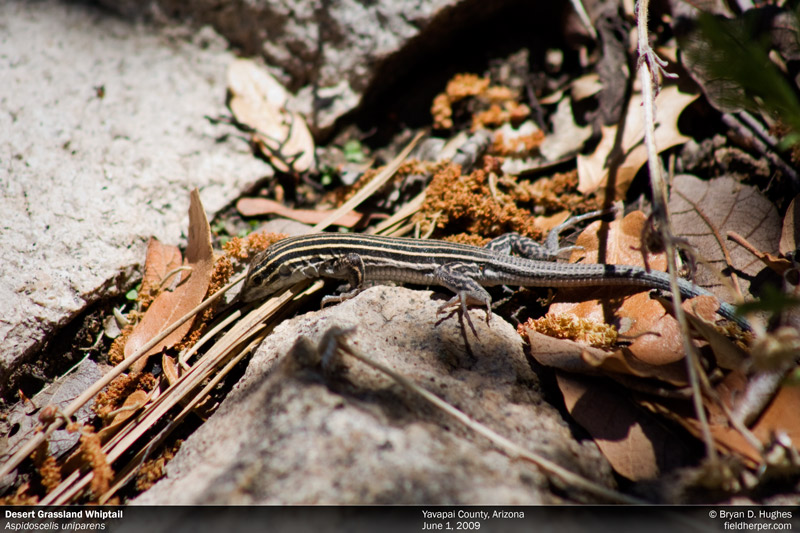
Desert Grassland Whiptail
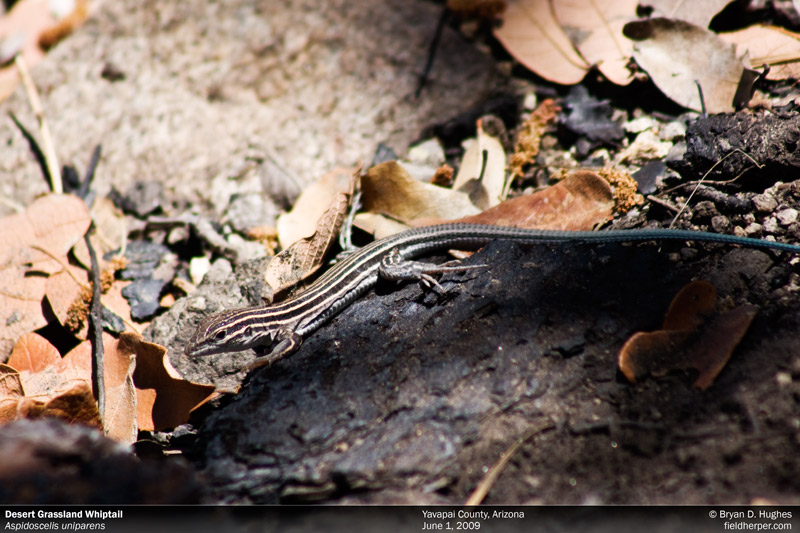
Tags: arizona, desert grassland whiptail, Field Herping, lizard, Photography, uniparens, whiptail
Posted in Field Herping | 1 Comment »
Here’s a young regal horned lizard (Phrynosoma solare) just after squirting me, my phone, and my camera with blood from its eyes. They do this to scare off mamilian predators, which I guess means me. I must admit it worked, as unlike the a bite from the little guy, it got me to put him down to wipe the stuff off my glasses. If coyotes wore glasses, this defense would be air-tight.
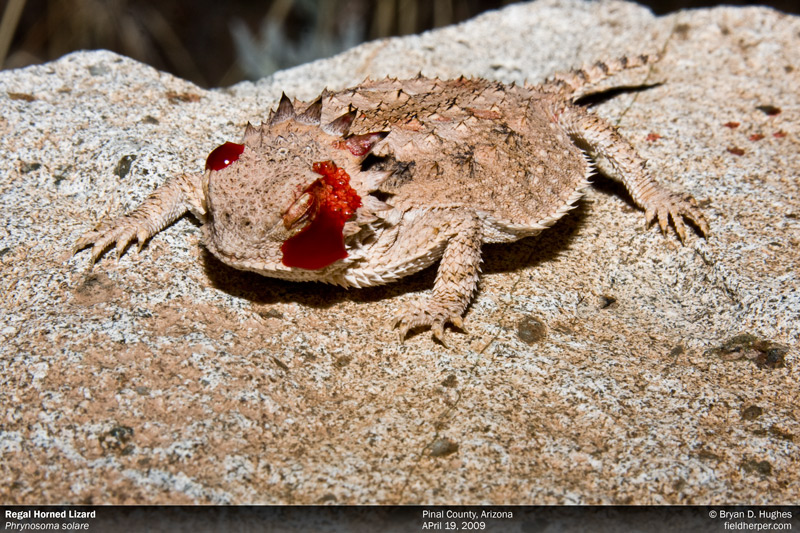
Phrynosoma solare
Tags: blood, defensive behavior, lizards, phronosoma solare, regal horned lizard
Posted in Behavior, Field Trips | 4 Comments »
One of hundreds of instances of Plateau Fence Lizard, Sceloporus tristichus, I see when in the higher elevation forests of the Bradshaw Mountains North of Phoenix. This is the first I have photographed, since I had previously assumed they were something else. Good to slow down and look around once in awhile!

Plateau Fence Lizard
Tags: arizona, bradshaw mountains, bryan d. hughes, field herping arizona, lizards, Plateau Fence Lizard, Sceloporus tristichus
Posted in Field Herping | 1 Comment »
I found 2 large, adult Sonoran Gophersnakes (Pituophis catenifer affinis) within 50 feet of eachother in the early evening in April. Neither wanted to fight, which was a little uncommon for these guys. It left me a little disappointed, because it’s fun to see these large constrictors put on their impressive show of puffing, hissing, and strikes.
Oh well, still good to see them.
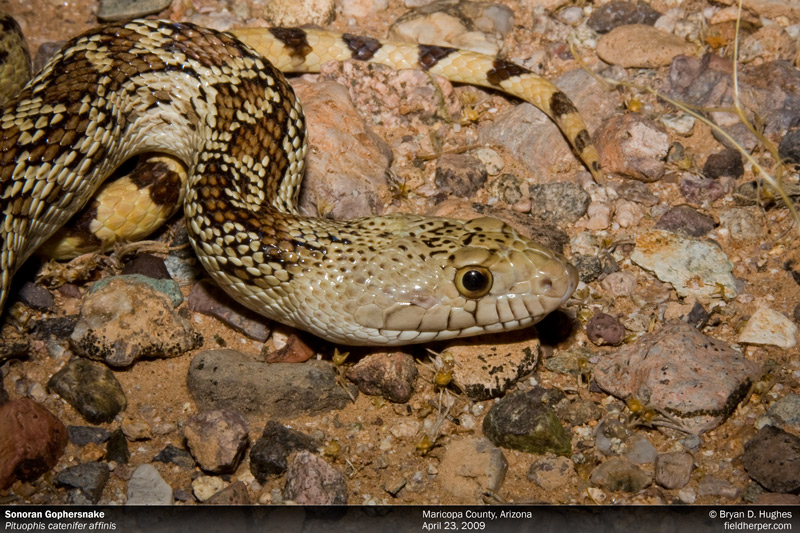
Sonoran Gophersnake
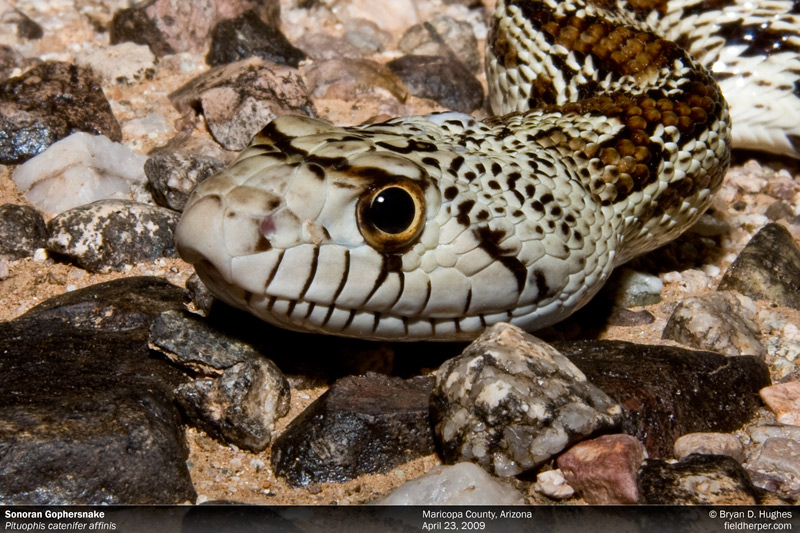
Pituophis catenifer affinis
Tags: Field Herping, Pituophis catenifer affinis, sonoran gophersnake
Posted in Field Herping | 2 Comments »
An unsuccessful trip to the S. E. portion of Arizona on the hunt for Green Ratsnakes and Brown Vinesnakes ended up yielding some worthwhile byproducts. A cattle pond full with one log and a good number of Sonoran Mud Turtles , Kinosternon sonoriense, basking in the sun. These are the first that I’ve seen of this species. One more for the life list. There is one time that I found several empty shells of these turtles in the Superstition Mountains, in the rocks near the bank. Some bird had a good meal.
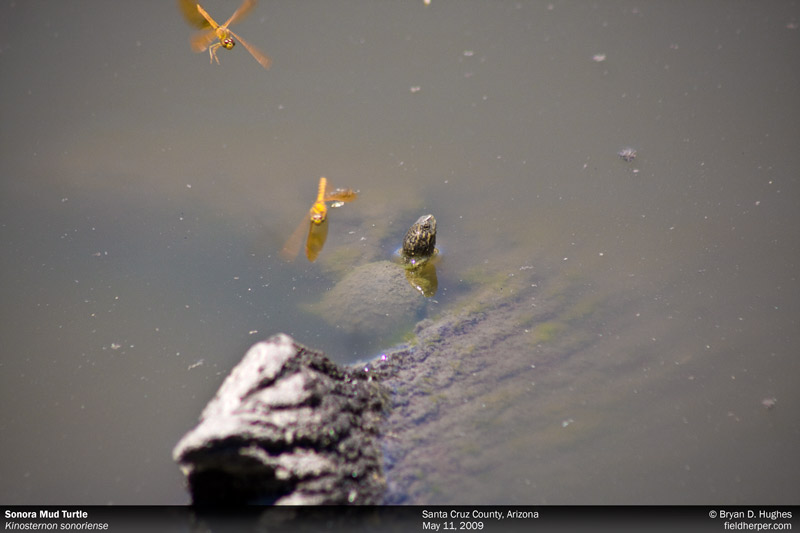
Sonoran Mud Turtle
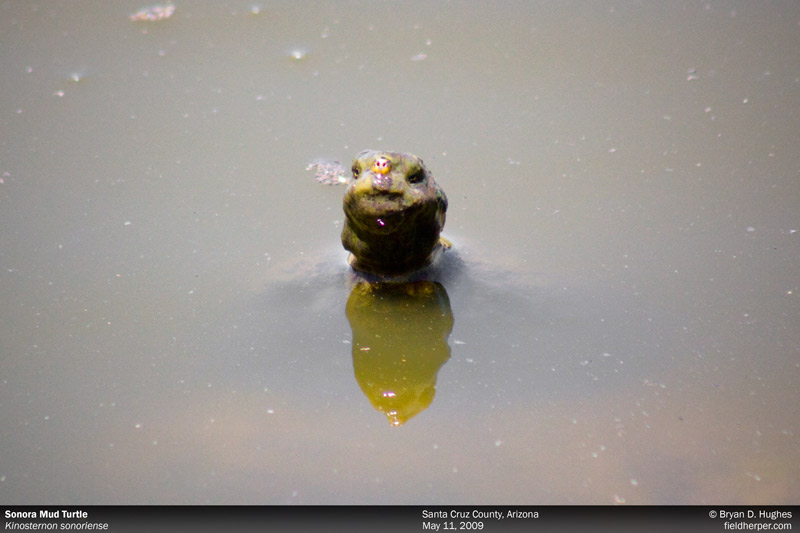
Kinosternon sonoriense
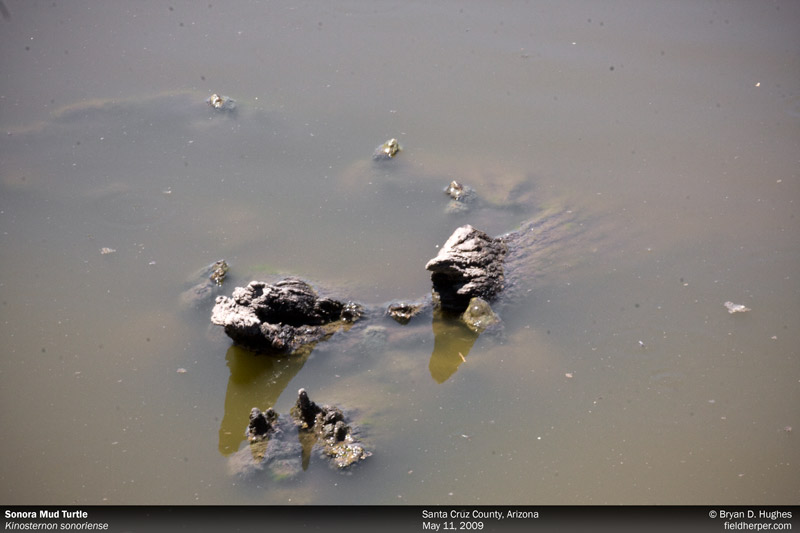
Sonoran Mud Turtles

Sonoran Mud Turtles
Tags: arizona, bryan d. hughes, Field Herping, field herping in arizona, Kinosternon sonoriense, santa cruz county, Sonora Mud Turtle, turtles
Posted in Field Herping | No Comments »
Here are two young mojave rattlesnakes (Crotalus scutulatus) I found within a quarter mile of eachother. I’ve seen my share of drab individuals, but these snakes are highly variable in color and pattern, and each seems interesting for this reason. I’ve seen them range anywhere from lime green to nearly black.
These are fairly typical of the type you’d find West of Phoenix, but they show some of the pattern variation that occur in individuals that live in the same area.
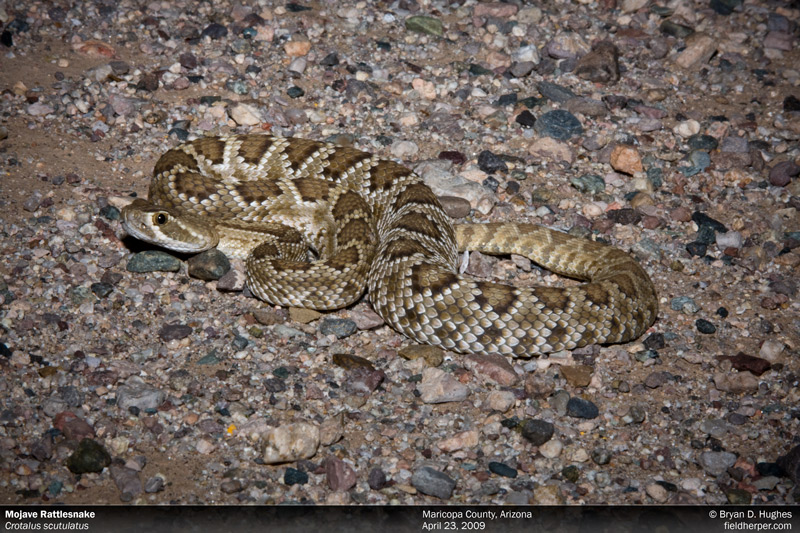
Crotalus scutulatus
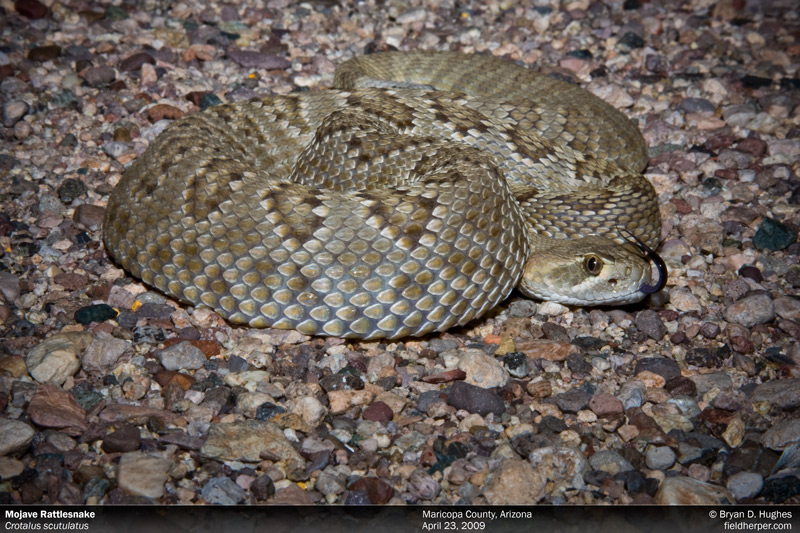
c-scutulatus-1-042409
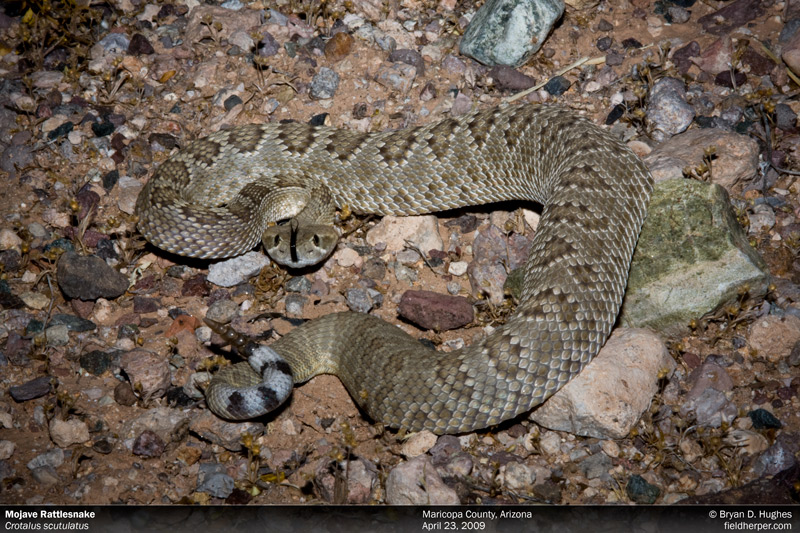
Mojave Rattlesnake
Tags: arizona, Crotalus scutulatus, Field Herping, mojave rattlesnake, mutation, variation
Posted in Field Herping | 3 Comments »
Here’s an example of one of the large, diurnal snakes I often see while looking for other snakes, a Sonoran Whipsnake (Coluber bilineatus). They’re really fast, hard to get your hands on, and extremely aggressive if you do manage to catch one. Fun stuff.
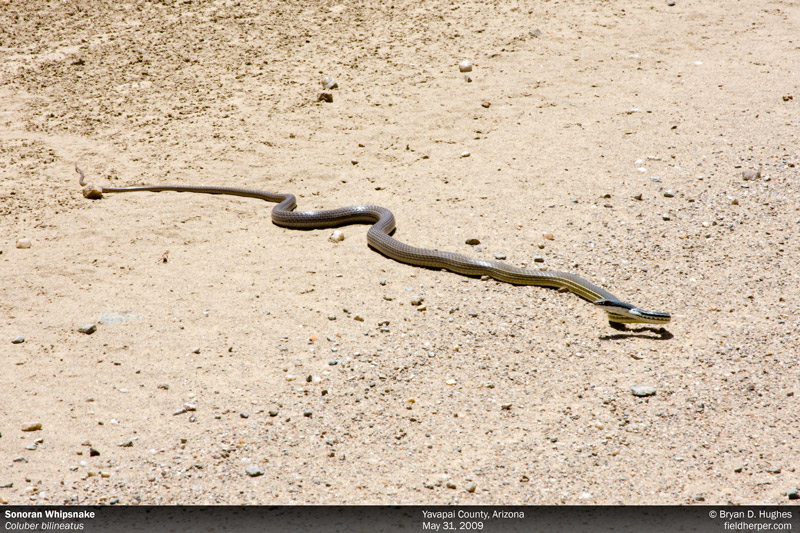
Coluber bilineatus
Tags: arizona, bryan d. hughes, Coluber bilineatus, Field Herping, snakes in Arizona, sonoan whipsnake, Yavapai County
Posted in Field Herping | No Comments »
That’s what I thought when I encountered my first long-nosed snake (Rhinocheilus lecontei) several years ago. Many snakes have a defensive behavior called “musking” that’s an evacuation of feces and various smelly whatnot from the cloaca. Some go a step further and write around in it to cover themselves in a disgusting mess, making them less appetizing. I must say it works. The long-nosed snake brings blood to the mix, leading me to believe the first several I picked up had been hit by a car before I found them.
Here’s one I moved off the roadway, which covered itself (and my hands) in it’s own poop and blood along the way.
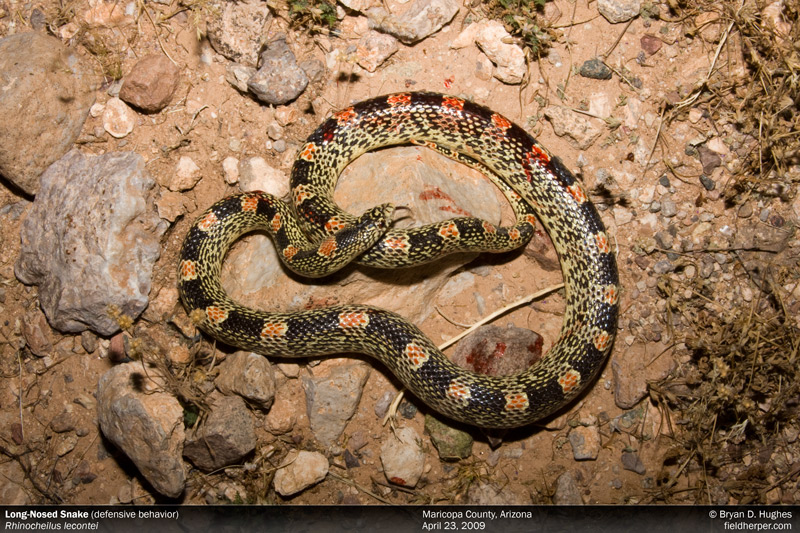
Rhinocheilus lecontei

Long-Nosed Snake
Tags: defensive behavior, Long-nosed snake, Longnose Snake, musk, musking, Rhinocheilus lecontei
Posted in Field Trips | 1 Comment »
Since moving to the Northern area of Phoenix (Anthem), I’ve been looking forward to getting into some higher elevations to look for some of the species that live there. Here are the first and second.
The first is a young Greater Short-Horned Lizard (Phrynosoma hernandesi) enjoying the early evening sun.
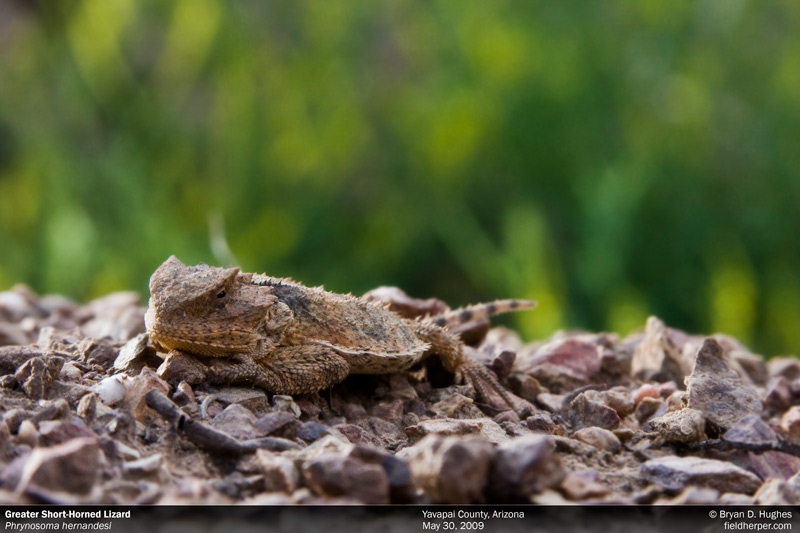
Phronosoma hernandesi
Desktop Wallpaper Version:
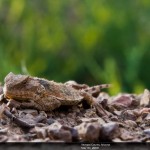
1650 x 1100 desktop
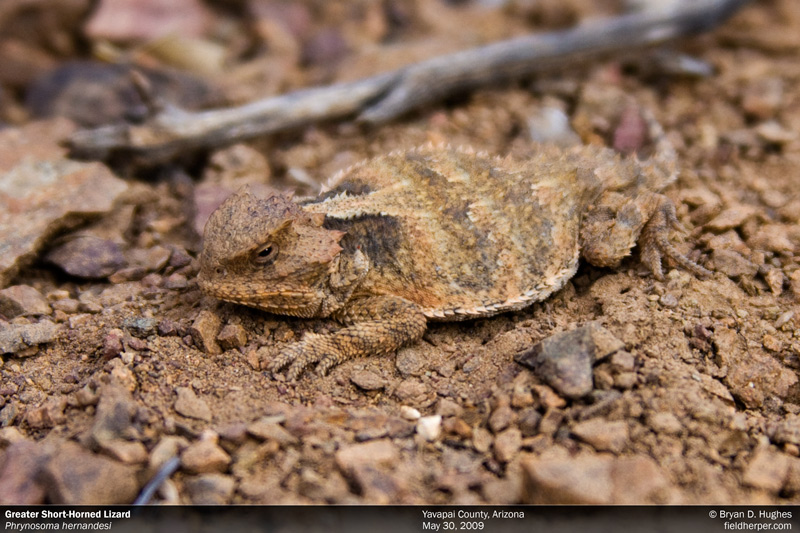
Greater Short-Horned Lizard
The second is the first Madrean Alligator Lizard (Elgaria kingii) I’ve been able to photograph. I’ve seen one other one, but it slipped through my fingers in tall grass.
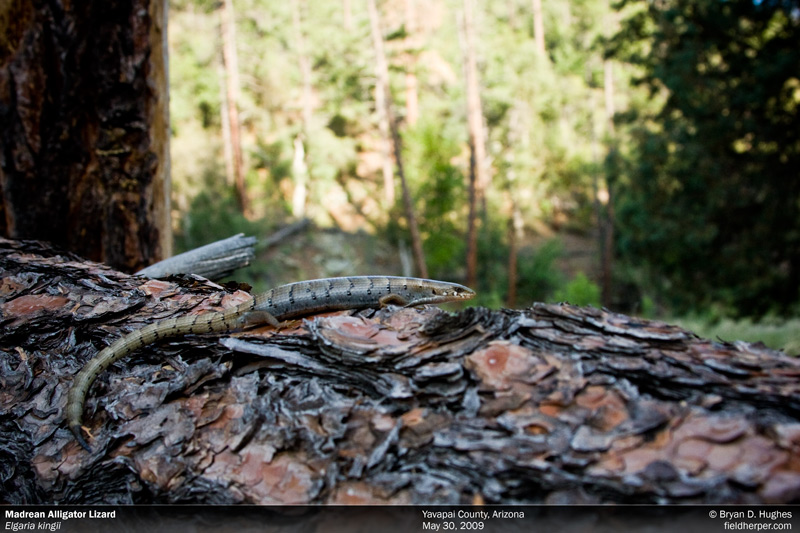
Madrean Alligator Lizard
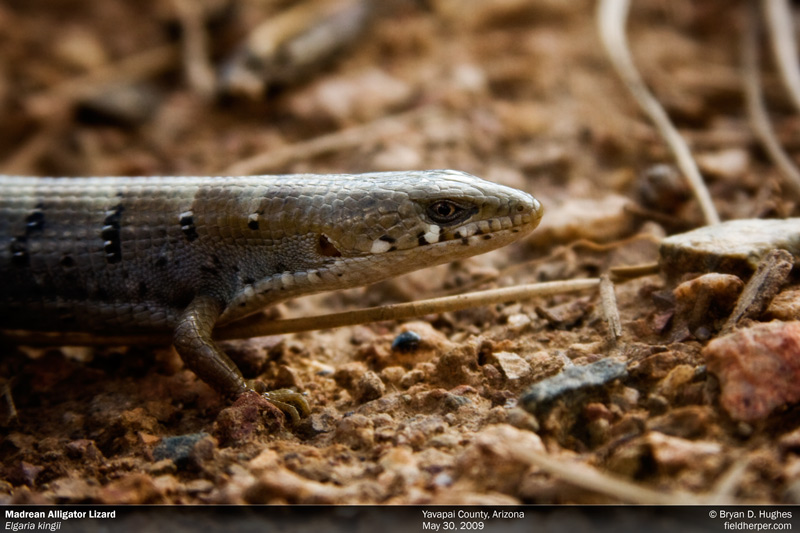
Elgaria kingii
Desktop Wallpaper Version:
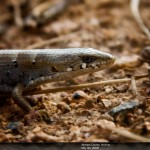
1650 x 1100 wallpaper
Here was my view at about 8 a.m.
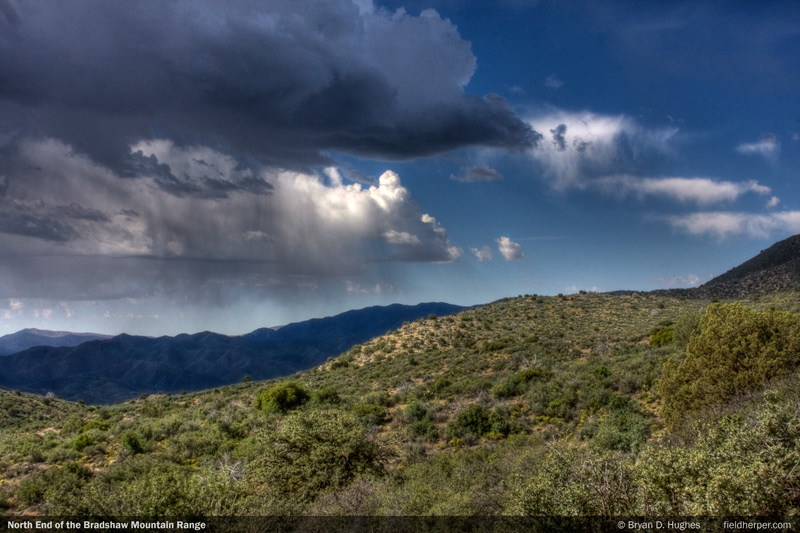
Bradshaw Mountains
Tags: arizona, bryan d. hughes, elgaria kingii, Field Herping, field herping arizona, field herping in arizona, Greater Short-Horned Lizard, horned lizard, madrean alligator lizard, Photography, phrynosoma hernandesi
Posted in Field Herping, Field Trips, Photography | No Comments »
This is probably my favorite of the native colubrid snakes we have here in Arizona: a juvenile Sonoran Lyresnake (Trimorphodon lambda). They usually inhabit rocky areas in the mountains, but this one was found on flat ground many hundreds of yards from the nearest rocky outcropping.
It is a bit on the venomous side, though a bite to humans won’t do more than potentially hurt like hell for a few hours. I took this one home with me, where it immediately devoured a greater earless lizard.
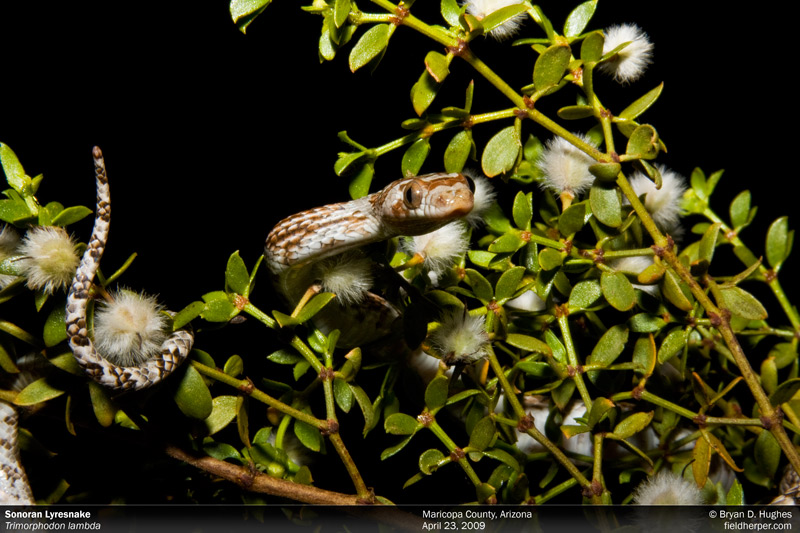
Trimorphodon lambda
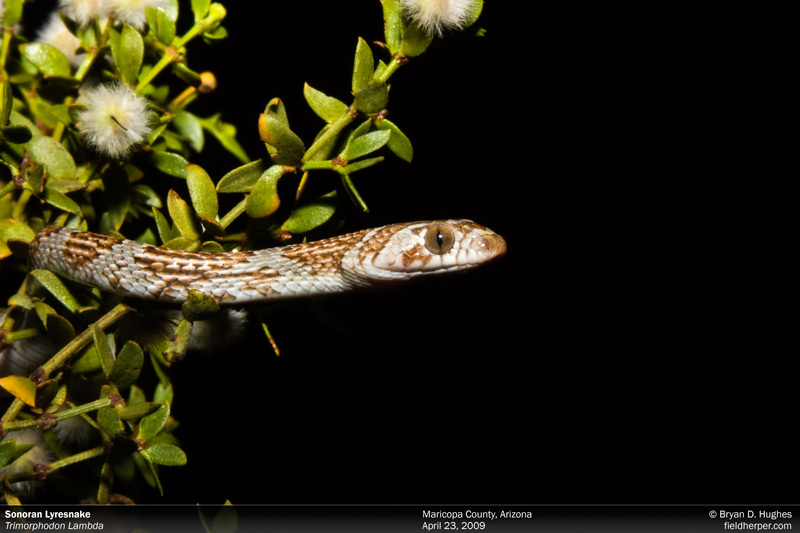
Trimorphodon lambda
Tags: colubrid, Field Herping, montaine, sonoran lyresnake, trimorphodon lambda
Posted in Field Trips | No Comments »
The Western Banded Gecko (Coleonyx variegatus) is very common in the Sonoran desert, and can easily be found under rocks during the day, where they lie in wait for dark. At night, they’re easily encountered as well. The pattern can be pretty variable as well. I’ve seen them with such diminished patterning that they look almost a solid tan/pink color, as well as banded, spotted, and any combination of both.
The tiny bead-like scales and flexible skin give them an incredibly soft texture. They’re also capable of vocalizing, which is unique in lizards to the geckos. When scared, they will sometimes chirp.
They are easily sexed, as males have large, visible bulges to either side of the tail base. This one is a female.
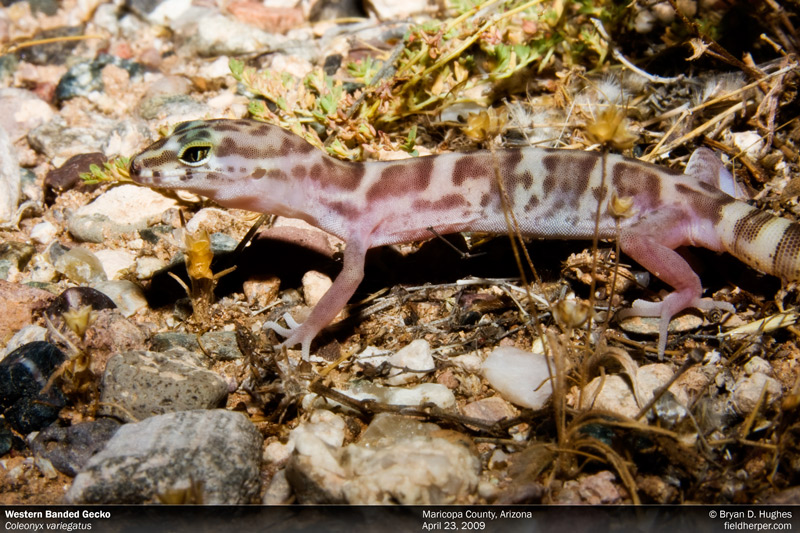
Westen Banded Gecko
Tags: arizona, Coleonyx variegatus, Field Herping, lizards, western banded gecko
Posted in Field Herping | No Comments »
The Colorado desert scrub that makes up much of the wild areas to the West of Phoenix are absolutely crawling with Sonoran Sidewinders (Crotalus cerastes cercobombus) on warm nights in the springtime. They all look incredibly similar as well, for the most part. When they’re moving I typically see 5 or more in an outing. I always photograph the first one, and then just check to make sure the others don’t have some cool mutation or something, and let them be on their way. Here are a three of the 10 instances of these small rattlesnakes I found within 2 evenings in April.
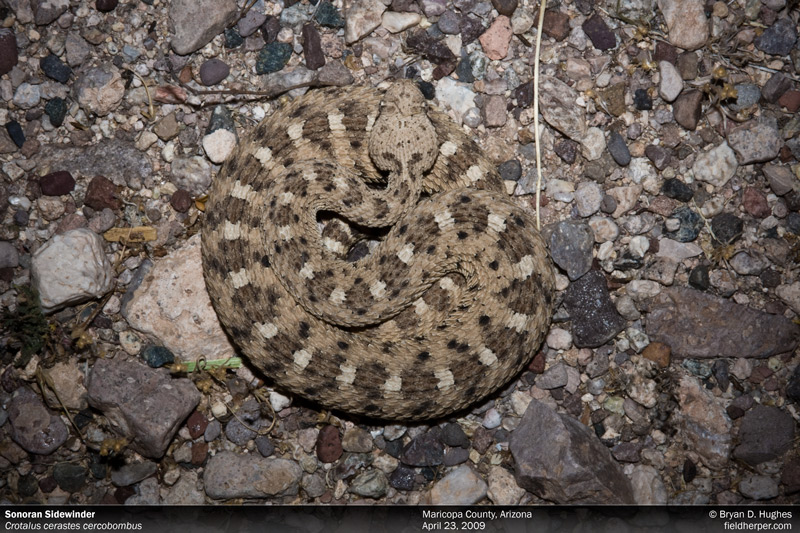
Sonoran Sidewinder
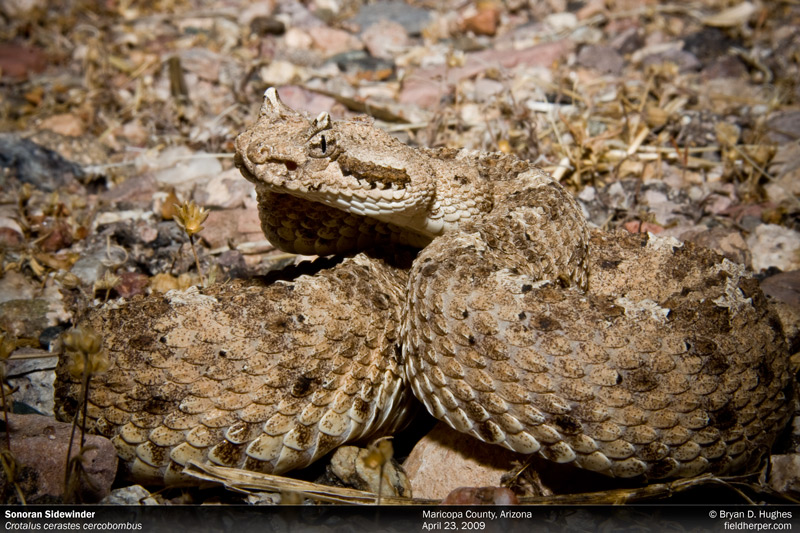
Crotalus cerastes cercobombus

Crotalus cerastes cercobombus
Tags: arizona, crotalus cerastes cercobombus, Field Herping, field herping arizona, pictures, rattlesnakes, sonoran sidewinder
Posted in Field Herping | No Comments »






























